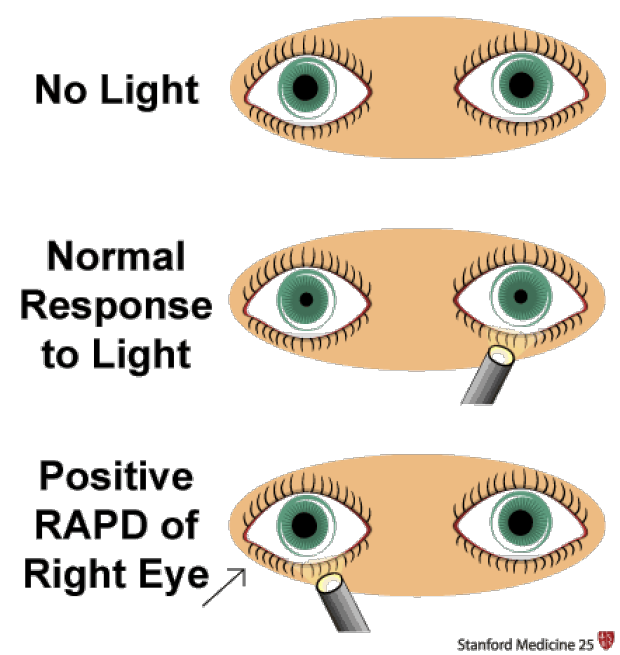A nurse documents that the client has a normal pupillary light reflex. The nurse should recognize that this reflex indicates which of the following?
The eyes converge to focus on the light.
The eye focuses the image in the center of the pupil.
Dilation of both pupils occurs in response to bright light.
Constriction of both pupils occurs in response to bright light.
The Correct Answer is D
A. The eyes converge to focus on the light.
This statement refers to the convergence reflex, where both eyes move medially (towards each other) to maintain single binocular vision when focusing on a near object. It is not related to the pupillary light reflex, which involves changes in pupil size in response to light.
B. The eye focuses the image in the center of the pupil.
This choice does not accurately describe the pupillary light reflex. The pupillary light reflex involves constriction of the pupil in response to light, not focusing an image in the center of the pupil.
C. Dilation of both pupils occurs in response to bright light.
This statement is incorrect. In response to bright light, the pupils should constrict, not dilate. Dilation of pupils in bright light could indicate an abnormal response, such as in cases of certain neurological conditions or drug use.
D. Constriction of both pupils occurs in response to bright light.
This choice is correct. In the pupillary light reflex, both pupils constrict when exposed to bright light. This response is a protective mechanism to prevent excessive light from entering the eyes, ensuring optimal visual acuity.

Nursing Test Bank
Naxlex Comprehensive Predictor Exams
Related Questions
Correct Answer is C
Explanation
A. Xiphoid process:
The xiphoid process is a small, cartilaginous extension at the inferior end of the sternum (breastbone). It does not play a role in the bifurcation of the trachea.
B. Suprasternal notch:
The suprasternal notch, also known as the fossa jugularis sternalis or jugular notch, is the visible dip in the superior part of the manubrium of the sternum between the clavicular notches. It is an important anatomical landmark for assessing the position of the trachea during emergency situations but is not the location of tracheal bifurcation.
C. Sternal angle (Angle of Louis):
The sternal angle, or Angle of Louis, is a palpable notch located at the articulation of the manubrium and the body of the sternum. It is where the second rib attaches and serves as a useful reference point for counting ribs and locating internal structures like the tracheal bifurcation.
D. Costal angle:
The costal angle is the acute angle formed by the junction of the costal margins at the xiphoid process. It is not related to the tracheal bifurcation.

Correct Answer is C
Explanation
A. Discuss that a light will be directed at the neck to observe for pulsations of the artery:
This choice is incorrect. Directing light at the neck is not a standard method for assessing carotid artery pulsations. The carotid artery is usually assessed by palpation to feel the pulse rather than visual observation.
B. Instruct the client to take a deep breath and "hold" while the nurse briefly auscultates:
This choice is incorrect. Auscultation is typically not used to assess carotid artery pulsations. Palpation (feeling the pulse) is the primary method used for this assessment.
C. Demonstrate that both arteries will be palpated simultaneously to compare amplitude:
This choice is correct. Palpating both carotid arteries simultaneously allows the nurse to compare the amplitude (strength) of the pulses. This comparison helps in assessing the symmetry of the pulses and ensures there are no significant differences between the two sides, which could indicate vascular abnormalities.
D. Show the client the diaphragm of the stethoscope that will be placed on the neck:
This choice is incorrect. The diaphragm of the stethoscope is not typically used for palpating pulses. Palpation involves using the fingertips to feel the pulse and assess its strength and regularity.
Whether you are a student looking to ace your exams or a practicing nurse seeking to enhance your expertise , our nursing education contents will empower you with the confidence and competence to make a difference in the lives of patients and become a respected leader in the healthcare field.
Visit Naxlex, invest in your future and unlock endless possibilities with our unparalleled nursing education contents today
Report Wrong Answer on the Current Question
Do you disagree with the answer? If yes, what is your expected answer? Explain.
Kindly be descriptive with the issue you are facing.
